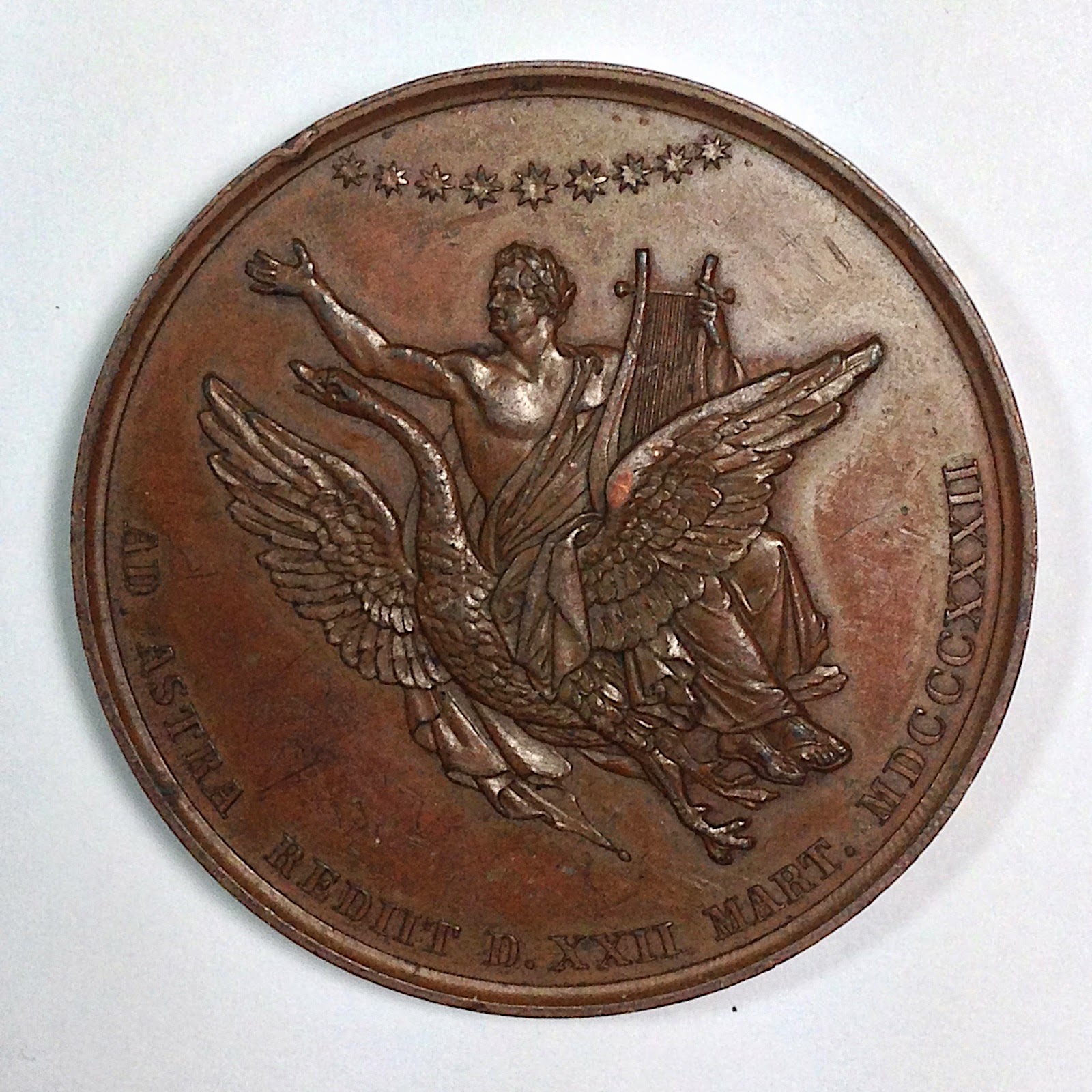I am more behind than usual in sending traditional paper/print holiday greetings. For a variety of reasons, I didn't manage to get out any Christmas cards, as such, in time for the holiday. But I did at least manage to reflect briefly on some of the iconography associated with the occasion.
Here is
an image that I've customarily used on one of the greeting cards that I
send. It comes from my research into German book history.
 |
| The Nativity: Vignette from the Gospel according to Saint Matthew |
(
enlarge)
The unsigned copper engraving (approximately 10 x 19.5 cm) is from my battered but treasured copy of:
Biblia, Das ist: Die gantze Heilige Schrifft Alten und Neuen Testaments :
nach der Übersetzung und mit den Vorreden und Randglossen D. Martin
Luthers ... / ausgefertiget unter der Aufsicht und Direction Christoph
Matthäi Pfaffen, der Heil. Schrifft Doctorn, Professorn, Cantzlern und
Probsten zu Tübingen, auch Abbten des Closters Lorch. - Mit Censur des
Hochfürstl. Würtemberg. Consistorii und Löbl. Theologischer Facultät zu
Tübingen, auch Allergnädigsten Privilegiis (Tübingen: Verlegt und gedruckt von Johann Georg und Christian Gottfried Cotta. Im Jahr Christi 1729).
The
massive folio volume,
illustrated, and edited with commentary by Professor Christoph Matthäus
Pfaff (1686-1760) of the University of Tübingen, was at once a
bibliophile production, thus a representative declaration of Christian
faith (simply owning such a large and expensive work was a statement of sorts), and a pragmatic attempt to bridge theological differences in an
age in which Lutheran orthodoxy contended with pietist challenges in the
Duchy of Württemberg, which remained a bastion of hard-core Evangelical
Protestantism in the otherwise largely Catholic German south.
The
iconic scene of the Holy Family in the stable stands at the beginning
of the Gospel According to Saint Matthew, thus introducing the New
Testament as a whole (the other Gospels are not similarly graced with
vignettes).
The
Gospel of Matthew,
as such, of course, mentions none of this. Instead, after a long
genealogy establishing Jesus' necessary descent from King David, and the
story of the Annunciation, it leaps right to the birth of Jesus. But
there is no mention of the details, or of a location more specific than
the messianically mandated Bethlehem. Instead, we suddenly read of
Herod's concern over the birth of the King of the Jews when the three
Wise Men, having followed their star, arrive in Jerusalem. Only after
Herod interrogates the "chief priests and scribes" do he and the Magi
learn that the goal of the latter should be Bethlehem. And even then,
the gospel refers only to "the house" in which they find "the young
child with Mary his mother." That's all. They present their gifts. Then
warned in dreams by God and an angel, respectively, the Wise Men and the
Holy Family flee the wrath of Herod.
Our cozy and canonical image of the Nativity, as depicted in many a work of art, comes from the
Gospel according to Saint Luke, (The Gospels of
Mark and
John do not even deal with the Nativity and instead leap right into the career of the mature Jesus.)
And
even then, there are no details. Luke contains the familiar assertion
that Mary "brought forth her firstborn son, and wrapped him in swaddling
clothes, and laid him in a manger; because there was no room for them
in the inn" and that the shepherds, having heard the message of an angel
and the heavenly host, "came with haste, and found Mary, and Joseph,
and the babe lying in a manger." That's it. And a manger, contrary to
popular opinion and my childhood impressions, is not a stable, and
rather,
as the etymology implies, something that one finds
inside a stable: a trough or feeder for livestock, thus suitable to act as a sort of
ersatz crib for the baby Jesus. (For that matter, the whole
Nativity narrative is historically problematic; most recently, archaeologists have suggested that the
actual birthplace was Bethlehem in Galilee rather than Judea.)
The rest, with its familiar regiment of barnyard fauna, is the accretion of
tradition, though quite understandable as something that would appeal to
the lifeworld and sensibilities of a largely agrarian Europe in the coming two
millennia and to us now conveys a kind of nostalgic
Gemütlichkeit.
The
image in this Bible therefore embellishes the scene in that vein.
Within the Baroque frame of sinuous and symmetrically curving curling
acanthus leaves is a barn or stable, though a rather artificially neat
and clean one. And, although there are hay racks for the livestock all
around the perimeter of the structure, the little manger holding the
baby Jesus stands at the center: unrealistic and out of place in a
practical sense but theologically exactly where it needs to be. To the
left are Mary and Joseph (the latter
depicted, according to tradition, as elderly—perhaps
in order to downplay any suggestion of sexuality). To the right are the
shepherds (identifiable by their staves) in their customary poses of
obeisance, from kneeling to respectfully standing in contrapposto. In a
sense, they pull our attention to the right, and in emphasizing the
miracle and message that brought them hither, seem to violate the
symmetry, but the presence of the larger livestock in the left
foreground (those at the right are depicted as smaller and in the
background) exercises a countervailing weigh so that visual balance
seems to be maintained in the aggregate.
Embodying as
it does the most popular conception of the Nativity, the scene from Luke
thus serves as a visual introduction to the New Testament as a whole.
Emphasizing this, the frame bears in its corners
the traditional iconographic representations of each of the four Gospels, reflecting the chief attribute of each book: the bull (Luke), the lion (Mark), the angel (Matthew), and the eagle (John).
The
sophistication of this image, from its complex composition to the
refinement of the figures and the elegant cross-hatching, is all the
more apparent when we compare it with a later and and more humble
counterpart. The 1729 Cotta Bible, as noted, was a luxury work, for the
theologian and scholar, or for the patrician elite. The ordinary folk
purchased something a good deal simpler and cheaper.
Both the Cotta firm and its competitors also published budget Bibles in the more common
octavo format.
(Think of a book with covers whose dimensions are akin to those of a
typical modern paperback, or somewhat smaller than those of a Kindle
, but
which in this case is, of course, a good deal thicker: some two to
three inches/5 to 7.5 cm.) In 1793, the young Johann Friedrich Cotta
(1764-1832), who would become the greatest scion of the family, earning
it world renown as the publisher of the German Classicists and Europe's
leading liberal newspaper, brought out out 5,000 copies of one such
volume (by contrast, new titles in his catalogue at that time typically
appeared in pressruns of only 500-1000 copies). It contained no
illustrations, as such, only a few modest standard printers' ornaments
or vignettes to mark the transitions between sections.
Meanwhile
the Tübingen printer and notorious pirate publisher Wilhelm Heinrich
Schramm (who also worked for Cotta on other projects ) had brought out a
revised version of his own cheap edition of the Holy Scriptures:
BIBLIA, Das ist: Die ganze Heil. Schrift Alten und Neuen Testaments, nach der Teutschen Uebersetzung D. Martin Luthers ... (Tübingen, drukts und verlegts Wilhelm Heinrich Schramm, 1791
The
common title page for both Testaments in my copy is dated 1791, but the
separate title page for the New Testament bears the year 1794:
Das neue Testament unsers HErrn und Heylands JEsu Christi, verdeutschet durch D. Martin Luther...
(Tübingen, drukts und verlegts Wilhelm Heinrich Schramm, 1794)
The
illustrations in this volume are fewer and simpler (and of course
smaller) than in the Cotta folio Bible. To begin with, they are woodcuts
rather than copper engravings, and thus allow for less detail. Even
taking that into account, though, they are cruder in composition as well
as line.
The elaborate Baroque frame of the engraving in the 1729 folio gave the scene an almost
theatrical appearance, so that we had the sense of being privileged
observers, looking in on a scene in which the holy actors go about their
sacred business unaware of us. (Not for nothing did nineteenth-century
critics liken the proscenium stage, with its sharp separation of
audience and players, to the
Guckkasten—peep show, or peep box—of the village fair.) It was thus at once realistic and unrealistic.
 |
| Nativity Scene: c. 3.5 x 1.25 inches/ 9 x 3 cm |
Here
the frame has been reduced to a bare minimum, and the effect also
differs in other ways from that of its more elegant counterpart. Indeed,
the four Evangelists seem imprisoned rather than framed by the stark
black border. (St. Matthew, at upper left, looks absolutely desperate to
escape its confines, which in the meantime seem to be crushing poor St.
Luke at lower right.) Within the frame, there is
no attempt to produce a realistic perspectival architectural setting:
instead, the background consists mainly of an undifferentiated series of
vertical lines. There is a sort
of flatness to the whole. The human forms are similarly simplified
and flattened. It is tempting to call them cartoonish.
Certainly, they are not particularly elegant or accomplished. From the
standpoint of both composition and execution, then, the Schramm woodcut
may seem clumsy. The frame is simple, the background is simple, the
figures are crude.
That said,
there is a kind of naive charm and rustic vitality to the whole.
Mary's
devotion is apparent, even though the head of the baby Jesus looks like
one of those schematic skulls on a Puritan gravestone. Although
somewhat obscured by the forequarters of the horse or donkey in the
background, the bull at left turns his head to the right, captivated by
the array of figures paying homage to the infant. Further drawing our
attention to the mother and child is the outstretched arm of Joseph (for
we assume that the commanding gesture identifies him, even though the
staff might otherwise suggest one of the shepherds) above, despite (or
because of?) his lobster claw of a hand.
And even the
compositional clumsiness may ironically work to the artist's and
reader's advantage: although the figures awkwardly fill the space to the
extent that we fear they will bump their heads on the solid black
border, there is somehow a sense of immediacy lacking in the more
polished engraving of the 1729 folio. As a result, we feel ourselves to
be not voyeurs, but participant-observers in the miraculous scene.
Upon
reflection, then, one might just conclude that this print brings us
closer to that presumed stable and the lifeworld of Judean peasants
some two thousand years ago than does its more elegant Baroque
counterpart. In any case, it was by means of simple images such as these
that the average Christian in Central Europe formed a picture of the
Nativity some two centuries ago.




































